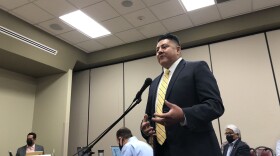Earlier this month, KUNM reported about an online portal, Districtr, where New Mexicans can draw and submit their own maps to the Citizen Redistricting Committee, or CRC, for consideration. Kathleen Burke, project coordinator of Fair Districts for New Mexico, spoke with KUNM about the importance of newly-released 2020 Census data now available on the portal.
KATHLEEN BURKE: Now that we have the current data uploaded, the public can create its own maps, which will reflect the current reality of populations in the state.
KUNM: What are some of the redistricting principles that census data like accurate populations or demographic data have an impact on. That is, what are important factors to keep in mind when building maps?
BURKE: We want districts to be fairly equal in population size. As some areas of the state have grown in population – say, the west side of Albuquerque, or the southern oil patch. Districts for those areas will shrink a bit in size so that it then becomes equal to neighboring districts because that population is more sparse. We also need to see how populations have changed demographically, geographically. Correct census data helps inform those, as well.
KUNM: Take racial demographics – what is the best practice for capturing a particular demographic makeup in each district?
BURKE: The hope is, if a community of interest exists, that community of interest will not be divided up among districts. That may be racial, and it may be a geographic community of interest. Say, where people all live on one side of one mountain. They may have very similar interests in preventing certain environmental intrusions. So, this community of interest wants to remain together so that they can defend their community.
KUNM: I can imagine some listeners may feel a little intimidated about some of these principles of redistricting. How can people learn more about how to make lawful maps, or maps in line with these best practices, so that submitting maps is an accessible thing to do?
BURKE: A great first step is for people to go to the Citizen Redistricting Committee website where they will find a portal, the Districtr program. And there are instructive videos to help people get started. Now, redistricting is not a simple process by any means. So, there are lots of redistricting guides on the internet about redistricting as a whole and how it's done, when it's done, etc.
KUNM: It looks like the folks at Districtr are holding some workshops, as well as study halls, where people can bring, you know, 'these are my ideas for a map, but I'm not quite sure how to make it happen.'
BURKE: Absolutely, yes. The workshops are typically one hour long and walks the attendees through the process of building their own maps. They do offer study halls where anyone can hop on and get one-on-one assistance. So, for anyone interested in making maps, there is a lot of support to get that done.
KUNM: You all have set a preferred-by date for map submissions. What is the significance of September 6th, Labor Day?
BURKE: At that point, the CRC really goes to work drawing their own maps. So, if we want the CRC to take into consideration the maps of the community, it's important that we all get our maps uploaded so that they can refer to our suggestions. After the 6th, our understanding is maps and comments will still be received. However, it's really going to be difficult to have an influence.
KUNM: And my understanding is that the CRC is planning on releasing their draft maps for public consideration on the 16th.
BURKE: Correct. The maps they consider to be the best rendering of fair maps, which they'll be sending to the legislature.
*****
This public service is part of our #YourNMGov project, in collaboration with KUNM radio. Support for public media provided by the Thornburg Foundation.





